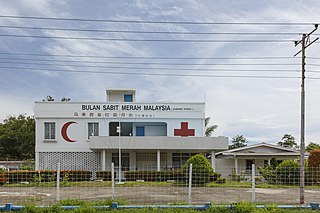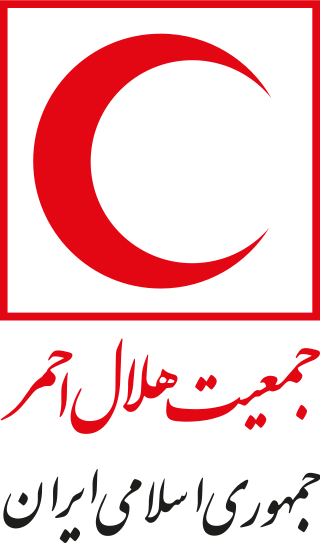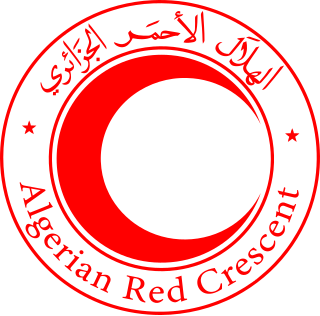
The organized International Red Cross and Red Crescent Movement is a humanitarian movement with approximately 16 million volunteers, members, and staff worldwide. It was founded to protect human life and health, to ensure respect for all human beings, and to prevent and alleviate human suffering. Within it there are three distinct organisations that are legally independent from each other, but are united within the movement through common basic principles, objectives, symbols, statutes, and governing organisations.
Humanitarian assistance is aid and action designed to save lives, alleviate suffering, and maintain human dignity during and after man-made crises and disasters. It encompasses a wide range of activities, including providing food, water, shelter, medical care, and protection. Humanitarian assistance is grounded in the principles of humanity, impartiality, neutrality, and independence.

Under the Geneva Conventions, the emblems of the International Red Cross and Red Crescent Movement are to be worn by all medical and humanitarian personnel and also displayed on their vehicles and buildings while they are in an active warzone, and all military forces operating in an active warzone must not attack entities displaying these emblems. The International Red Cross and Red Crescent Movement recognizes four protection emblems, three of which are in use: the Red Cross, the Red Crescent, the Red Lion and Sun, and the Red Crystal.
The Cyprus Red Cross Society is the only Red Cross society in Cyprus recognised by the International Red Cross and Red Crescent Movement. The Headquarters of the Society are located in Nicosia.

The International Committee of the Red Cross is a humanitarian organization based in Geneva, Switzerland, and is a three-time Nobel Prize Laureate. The organization has played an instrumental role in the development of rules of war and promoting humanitarian norms.
The Ethiopian Red Cross Society (ERCS) (Amharic: የኢትዮጵያ ቀይ መስቀል ማኅበር) is a humanitarian organization working in partnership with the Ethiopian government, the International Federation of the Red Cross and Red Crescent Societie (IFRC), the International Committee of the Red Cross (ICRC), national societies, volunteers and its beneficiaries. it currently has 6.35 million fee-paying adult and youth members and more than 500, 000 volunteers.

The Malaysian Red Crescent (MRC) is a voluntary humanitarian organization that seeks to promote humanitarian values, as well as provide service and public education in disaster management, as well as healthcare in the community. It is part of the International Red Cross and Red Crescent Movement.
The Code of Conduct for International Red Cross and Red Crescent Movement and NGOs in Disaster Relief was drawn up in 1992 by the Steering Committee for Humanitarian Response (SCHR) to set ethical standards for organizations involved in humanitarian work. In 1994, the SCHR adopted the code and made the signing of it a condition for membership in the alliance.
There are a number of meanings for the term humanitarian. Here, humanitarian pertains to the practice of saving lives and alleviating suffering. It is usually related to emergency response whether in the case of a natural disaster or a man-made disaster such as war or other armed conflict. Humanitarian principles govern the way humanitarian response is carried out.

The International Federation of Red Cross and Red Crescent Societies (IFRC) is a worldwide humanitarian aid organization that reaches 160 million people each year through its 191 member National Societies. It acts before, during and after disasters and health emergencies to meet the needs and improve the lives of vulnerable people. It does so independently and with impartiality as to nationality, race, gender, religious beliefs, class and political opinions.
The Red Cross Society of Bosnia and Herzegovina is a component of the International Red Cross and Red Crescent Movement. It was recognized by the International Committee of the Red Cross (ICRC) on 8 May 2001 and admitted as a member to the International Federation of Red Cross and Red Crescent Societies (IFRC) on 7 November 2001.

The Finnish Red Cross is an independent member of the International Federation of Red Cross and Red Crescent Societies, which is one of the biggest and best-known international organisations in the world and in the field of humanitarian aid. FRC has over 71,000 members and around 30,000 active volunteers in Finland. FRC consists of 12 regional chapters and 433 local branches throughout the country. The current General Secretary is Eero Rämö. At the end of 2022, the FRC employed 787 people, of which 204 worked at the headquarters in Helsinki.
Mali Red Cross, also known as CRM, was founded in 1965 on the basis of the Geneva Conventions of August 1949 and of the order of 59 PCG 28 March 1959 governing associations and NGOs in the Republic of Mali. It is headquartered in Bamako. The primary goal of the Mali Red Cross is to provide aid to people suffering the combined effects of armed conflict, promote nutrition and health, and provide assistance during food shortages. The International Federation of Red Cross and Red Crescent Societies (IFRC) recognized the Mali Red Cross on September 14, 1967, as the 109 national society of the Red Cross and Red Crescent Societies.

The Iranian Red Crescent Society (IRCS), officially the Red Crescent Society of the Islamic Republic of Iran is a non-governmental humanitarian organization in Iran. Founded as the Red Lion and Sun Society in 1922, it became affiliated with the International Federation of Red Cross and Red Crescent Societies (IFRC) in 1924 and changed its name and emblem in 1980, informing the international community of Hilal Ahmar adoption while assuming the right to adopt the former emblem in future.
The Colombian Red Cross is a Colombian-based nonprofit private entity member of the International Red Cross and Red Crescent Society. It has been a member since 1922. The Colombian Red Cross embraces the principles of the International Red Cross. It provides humanitarian aid to people in need of protection, protection of life and health during armed conflict and disaster relief during emergencies within the Colombian territory. The Colombian Red Cross has played a major humanitarian role within the Colombian Armed Conflict as a mediator in the area of human rights.

The Algerian Red Crescent is an Algerian humanitarian volunteer organization founded in 1957. It has been recognized by the International Red Cross and Red Crescent Movement only since 1963.
The Maldivian Red Crescent (MRC) is an independent, volunteer, non-profit, humanitarian organization established in the Maldives by virtue of the Maldivian Red Crescent Act Law No: 7/2009

Restoring Family Links (RFL) is a program of the Red Cross and Red Crescent Movement, more specifically the International Committee of the Red Cross (ICRC) and National Red Cross and Red Crescent Societies involving activities that aim to prevent separation and disappearance, look for missing persons, restore and maintain contact between family members and clarify the fate of persons reported missing. The activities are carried out by the components of the RFL is sometimes also referred to as family tracing.

The Standing Commission of the Red Cross and Red Crescent is the permanent statutory body of the International Red Cross and Red Crescent Movement and the highest deliberative body of the Movement between the meetings of the Council of Delegates and the International Conference of the Red Cross and Red Crescent. It was originally set up to coordinate cooperation between the International Committee of the Red Cross and the International Federation of Red Cross and Red Crescent Societies.










